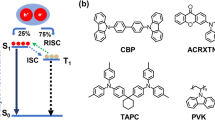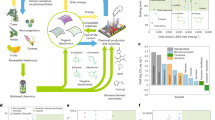Abstract
Using printed organic light-emitting diodes (OLEDs) for lighting, smart-packaging and other mass-market applications has remained a dream since the first working OLED devices were demonstrated in the late 1980s. The realization of this long-term goal is hindered by the very low abundance of iridium and problems when using low-cost wet chemical production processes. Abundant, solution-processable Cu(I) complexes promise to lower the cost of OLEDs. A new copper iodide NHetPHOS emitter was prepared and characterized in solid state with photoluminescence spectroscopy and UV photoelectron spectroscopy under ambient conditions. The photoluminescence quantum efficiency was determined as 92 ± 5 % in a thin film with yellowish-green emission centered around 550 nm. This puts the material on par with the most efficient copper complexes known so far. The new compound showed superior solubility in non-polar solvents, which allowed for the fabrication of an inkjet-printed OLED device from a decalin-based ink formulation. The emission layer could be processed under ambient conditions and was annealed under air. In a very simple stack architecture, efficiency values up to 45 cd A−1 corresponding to 13.9 ± 1.9 % EQE were achieved. These promising results open the door to printed, large-scale OLED devices with abundant copper emitters.






Similar content being viewed by others
References
Y. Tao, K. Yuan, T. Chen, P. Xu, H. Li, R. Chen, C. Zheng, L. Zhang, and W. Huang, Adv. Mater. 1 (2014)
D. Volz, Y. Chen, M. Wallesch, R. Liu, C. Fléchon, D.M. Zink, J. Friedrichs, H. Flügge, R. Steininger, J. Göttlicher, C. Heske, L. Weinhardt, S. Bräse, F. So, T. Baumann, Adv. Mater. 27, 2538 (2015)
H. Nakanotani, K. Masui, J. Nishide, T. Shibata, C. Adachi, Sci. Rep. 3, 2127 (2013)
D. Volz, M. Wallesch, C. Fléchon, M. Danz, A. Verma, J.M. Navarro, D.M. Zink, S. Bräse, T. Baumann, Green Chem. 17, 1988 (2015)
F. Dumur, Org. Electron. 21, 27 (2015)
F. Dumur, Synth. Met. 195, 241 (2014)
S. Youn Lee, T. Yasuda, H. Nomura, C. Adachi, Appl. Phys. Lett. 101, 093306 (2012)
S. Hirata, Y. Sakai, K. Masui, H. Tanaka, S.Y. Lee, H. Nomura, N. Nakamura, M. Yasumatsu, H. Nakanotani, Q. Zhang, K. Shizu, H. Miyazaki, C. Adachi, Nat. Mater. 14, 1 (2014)
K. Goushi, K. Yoshida, K. Sato, C. Adachi, Nat. Photonics 6, 253 (2012)
M. Wallesch, D. Volz, C. Fléchon, D. M. Zink, S. Bräse, and T. Baumann, in Proc. SPIE, edited by F. So and C. Adachi (2014), p. 918309
M. Wallesch, D. Volz, D. M. Zink, U. Schepers, M. Nieger, T. Baumann, and S. Bräse, Chem. Eur. J. 6578 (2014)
D. Volz, D.M. Zink, T. Bocksrocker, J. Friedrichs, M. Nieger, T. Baumann, U. Lemmer, S. Bräse, Chem. Mater. 25, 3414 (2013)
D.M. Zink, D. Volz, T. Baumann, M. Mydlak, H. Flügge, J. Friedrichs, M. Nieger, S. Bräse, Chem. Mater. 25, 4471 (2013)
D. Volz, M. Nieger, J. Friedrichs, T. Baumann, S. Bräse, Langmuir 29, 3034 (2013)
J. Leitl, V.A. Krylova, P.I. Djurovich, M.E. Thompson, H. Yersin, J. Am. Chem. Soc. 136, 16032 (2014)
M.J. Leitl, F.-R.R. Küchle, H.A. Mayer, L. Wesemann, H. Yersin, J. Phys. Chem. A 117, 11823 (2013)
R. Czerwieniec, K. Kowalski, H. Yersin, Dalt. Trans. 42, 9826 (2013)
Q. Zhang, T. Komino, S. Huang, S. Matsunami, K. Goushi, C. Adachi, Adv. Funct. Mater. 22, 2327 (2012)
S.O. Jeon, J.Y. Lee, J. Mater. Chem. 22, 7239 (2012)
B. Riedel, I. Kaiser, J. Hauss, U. Lemmer, M. Gerken, Opt. Express 18, A631 (2010)
H. Yersin, A.F. Rausch, R. Czerwieniec, T. Hofbeck, T. Fischer, Coord. Chem. Rev. 255, 2622 (2011)
Acknowledgments
This work has been sponsored by the German Federal Ministry of Education and Research. (BMBF) in the funding programs “cyCESH” and “cyFLEX”. Also, we acknowledge funding from the European Union in the LEO project (H2020-ICT-2014-1 call). D.V. thanks the R&D division of CYNORA and his collaboration partners, amongst them Stefan Bräse, Clemens Heske, Uli Lemmer and Christopher Barner-Kowollik (Karlsruhe Institute of Technology), Hartmut Yersin (University of Regensburg) and Franky So (North Carolina State University) for their continued support.
Author information
Authors and Affiliations
Corresponding author
Electronic supplementary material
Below is the link to the electronic supplementary material.
Rights and permissions
About this article
Cite this article
Verma, A., Zink, D.M., Fléchon, C. et al. Efficient, inkjet-printed TADF-OLEDs with an ultra-soluble NHetPHOS complex. Appl. Phys. A 122, 191 (2016). https://doi.org/10.1007/s00339-016-9726-2
Received:
Accepted:
Published:
DOI: https://doi.org/10.1007/s00339-016-9726-2




